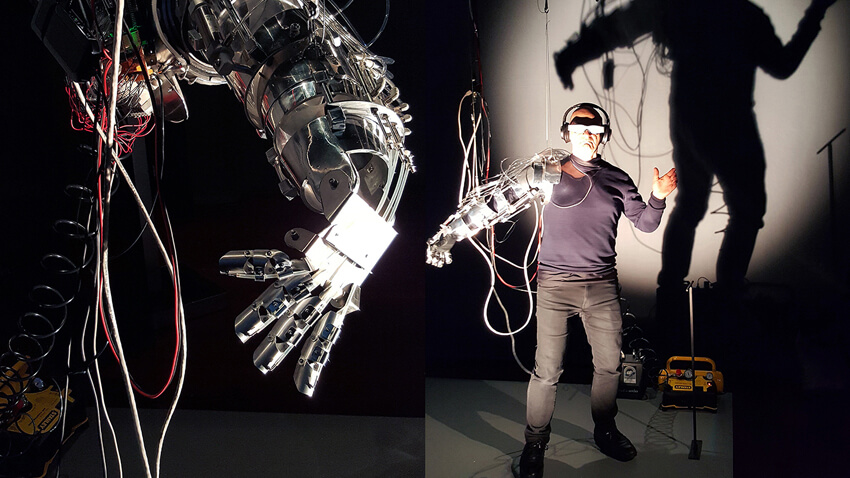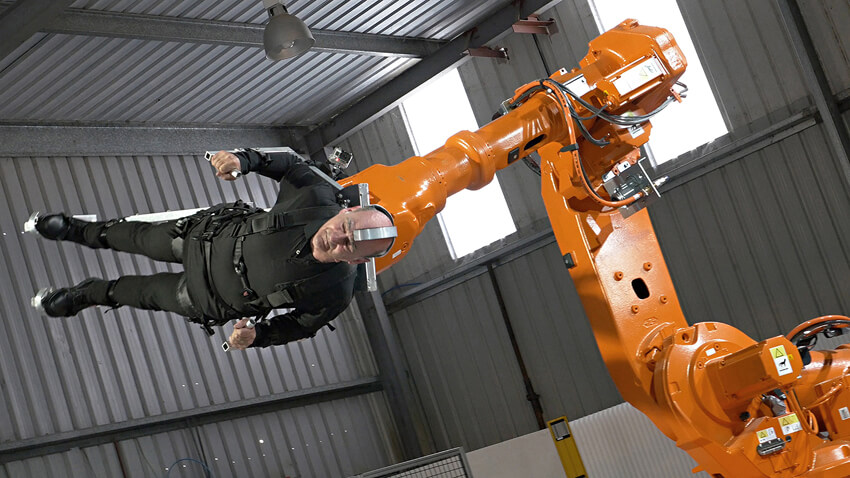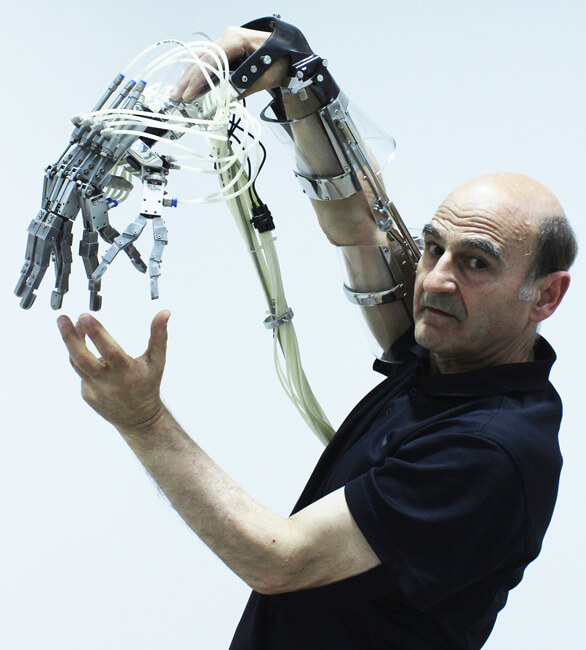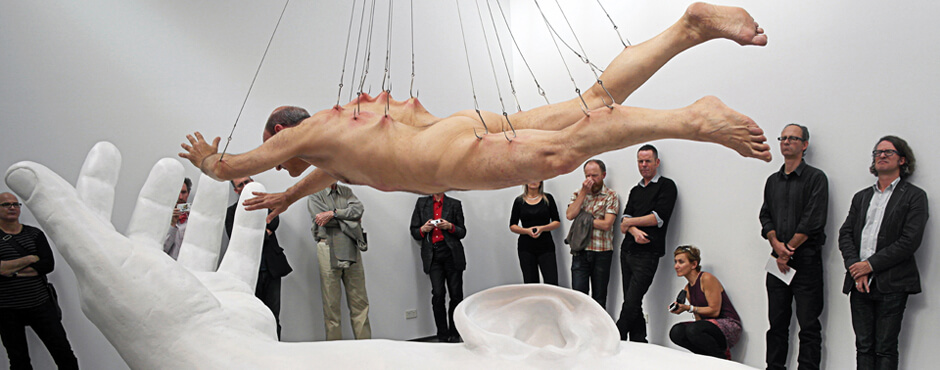Interview by Lula Criado
 Re-Wired / Re-Mixed: Event for Dismembered Body. Radical Ecologies, PICA, Perth (2016.) Photo credit: Steven Aaron Hughes
Re-Wired / Re-Mixed: Event for Dismembered Body. Radical Ecologies, PICA, Perth (2016.) Photo credit: Steven Aaron Hughes
Professor Stelarc, Distinguished Research Fellow at the School of Design and Art at Curtin University Perth, Australia, does not need an introduction. When he was kicked out of art school for not fulfilling course requirements in sculpture such as ‘carving, casting, moulding and welding’ the art school lost a student and thankfully we gained a cutting-edge performance artist who, since then, has been ‘breaking the rules’. Stelarc uses technology as well as his body, as a means to examine ideas around the obsolescence of the human body, its limitations, and its capabilities.
In this sense, his three most cutting-edge projects are the Suspensions, Third Hand performances and Ear On Arm, not only for challenging what art can be but also for extending the human condition beyond its biological form. He performed 26 suspensions between 1976-1988 across Japan, the USA, Australia, and Europe. The suspensions took part in private gallery spaces and remote locations, with the most captivating suspensions being the New York City Street Suspension and the Copenhagen City Suspension.
The Third Hand is actuated by electrical signals from his abdominal and leg muscles. This enabled individual control of his three hands. These augmented and amplified performances with his extra hand occurred from 1980 to 1999. On the other hand, Ear On Arm is surgically constructing and stem-cell growing an ear on Stelarc’s left forearm. He dreamt up the idea in 1996, but the extra ear was not incorporated as a part of his body until 2006. In the final phase of the project, the extra ear will be internet enabled so that it becomes a remote listening device for people in other places – a kind of ‘Internet organ for the body’. It will be both a hearing and transmitting ear.
With projects such as the Extended Arm, Exoskeleton, Virtual Body, Virtual Arm and Prosthetic Head, Stelarc provides us with a wider and deeper understanding of the profound limitations of the human body and of the possibility of alternate anatomical architectures. These projects and performances involve prosthetics, robotics, VR and AI. As he suggests, ‘we should dismiss the idea of an individual body and begin to think of the body as an extended operational system. The body is perceived as empty and meaningless (religious, scientific or philosophical). It is seen only as a physical object/artwork. And as Stelarc says, ‘the body is not as a site for the psyche nor for a social inscription but simply as a structure, as a sculpture’.
More recently, he performed Re-Wired / Re-Mixed: Event for Dismembered Body (2016) at PICA, Australia for the ‘Radical Ecologies’ exhibition. Re-Wired / Re-Mixed: Event for Dismembered Body was a five-day internet-enabled performance that explores ‘the physiological and aesthetic experience of a fragmented, distributed, de-synchronized, distracted and involuntary body’.
Wearing a heads-up display (HUD) enabled him to ‘see’ with the eyes of someone in London and ‘hear’ with the ears of someone else in New York, whilst anyone, anywhere, could generate involuntary movements of his right arm by accessing the exoskeleton using an online interface. Effectively, his vision was disconnected from his hearing, and his arm was disconnected from his body.
Stelarc’s framework lies both within and beyond the boundaries between man/machine/technology. Interrogating and altering the human condition and its relationship with technology is at the core of his artistic practices. He imagines that as technology becomes micro-miniaturised and nano in scale, we will be able to recolonise the human body with sensors and robots that will augment our bacterial and viral population. He sees the artist as generating ‘contestable futures, possibilities that can be experienced, articulated and possibly appropriated’.
 Propel: Body on Robot Arm. Autronics – DeMonstrable, Lawrence Wilson Gallery, Perth (2015). Photo credit: Steven Aaron Hughes
Propel: Body on Robot Arm. Autronics – DeMonstrable, Lawrence Wilson Gallery, Perth (2015). Photo credit: Steven Aaron Hughes


You are an artist working in the intersection of art/human art and science (robotics) could you tell us a little bit about the intellectual process?
I always wanted to be an artist, but In art school, I was never satisfied with conventional art-making processes. Flippantly, I started doing performance when I discovered I was a bad painter ha, ha. Majoring in sculpture you had to carve, cast, mould or weld and since I wasn’t doing those things I was kicked out of art school. They said I was not fulfilling the course requirements because I wasn’t using those conventional techniques. For example, I was making helmets and goggles that altered your binocular perception, that split your vision. Also, an electronic and motorised environment that your whole body was immersed in. Soon after I made three films of the inside of my body with endoscopic probes. In fact, it was approximately three metres of internal space probed into the lungs, stomach and colon.
The body was not only a structure but full of empty spaces and circulatory systems. So from the very beginning, I was interested in the human body and augmenting it in some way, adjusting its awareness. I was always reading about evolutionary theory and comparative anatomies. We have a body with two arms, two legs, two ears, and two eyes but then you have insects that have multiple legs, have pincers for manipulators, and have compound eyes. I discovered that dogs only see in black and white, snakes only sense in infrared, and bats and dolphins navigate via ultrasound. I realised these alternate anatomical architectures perceived and operated in the world in varied ways.
The German biologist Uexkull’s idea is that each animal has its own Umwelt. Furthermore, there was a realisation that the human body is profoundly obsolete in this technological terrain that we now inhabit and that the biological apparatus of the body is highly inadequate. Machines can operate faster, they can operate with more power, they can operate with more precision and they are more robust and reliable. As biological bodies, we could only interface in proximity to each other in the local space that we inhabited.
Now, with technology, we can collaborate and communicate online in real-time with our text, our voices and our faces. So, we have to begin to think of the body in a systemic way not merely as an individual body with its own agency but rather, as a distributed body of multiple agencies that can operate remotely and instantaneously with many bodies elsewhere. This is something that we all do now, but there is this nostalgic, romantic idea of individual bodies with minds of their own. We were never only biological bodies. What it means to be human is to be augmented and amplified. The body is an unstable construct. Perhaps what it means to be human is not to remain human at all.
Your work focuses on the capability of the human body and explores ideas around obsolesce, what are the possibilities and limitations of using your body for artistic proposals?
The more and more performances I do, the less and less I think I have a mind of my own nor any mind at all in the traditional metaphysical sense. You are looking at a body that’s obsolete, that’s empty, that’s involuntary. There’s nothing inside the body. We are very complex anatomical architectures, but we’re not very robust. We damage very easily, become diseased and we live a short life span of about seventy-five years in good health.
Then we quickly deteriorate and we die. Birth and death is an evolutionary strategy that guarantees genetic diversity and population control. But is the slow evolutionary process necessary and effective anymore if we can genetically intervene and if we can stem cells grow or 3D print replacement body parts and organs? Not to mention prosthetic replacements for amputated limbs and for malfunctioning kidneys and hearts. We are studying senescence and if we know how cells age then we will be able to perhaps reverse that ageing process. So, I’ve never considered the body as an object of desire but rather an object that needs to be redesigned.
That’s the approach to the human body and I guess the reason why I began doing performance. Also, I was kind of envious of dancers, gymnasts or singers who use their own bodies not only as a mode of expression but also as a means for the experience. If you do a performance, you have to take the physical consequences for your ideas. If I want to suspend my body I’ve got to be prepared to insert eighteen hooks into my skin. If I want to design a sculpture for the inside of my body, I’ve got to insert an endoscope 40cm into my stomach.
If I want to construct an ear on my arm, I have to be prepared to undergo several surgical and stem cell procedures. In realising the extra ear, there were problems with infection; and problems with necrotic tissue. So, in performance your biological embodiment makes it possible but also makes it problematic to undergo certain artistic actions. You are not dealing with images; you are not dealing with academic discourse. You are attempting to actualise your idea, personally experiencing it and therefore having something meaningful to say afterwards. The ideas that I’m speaking to you about have come from the projects and performance that I’ve done. In a sense, these ideas are authenticated by the actions of the artist, they’re not just some kind of imaginary.
When we speculate about the future, we try to extrapolate from present data and if we see that those statistics progress linearly we can imagine that there might be a predictable outcome which might even result in a singularity. I suspect though that the future will not be what it seems. Machines might take over but that’s only one contestable future. In fact, one can argue that in 2000 years, our bodies will be exactly the same as they are now.
The difference will be that internally our bodies will be populated by micro-sensors and nano-robots. In other words, all technology in the future will be invisible because it’s inside your body. The sort of manga, military and medical images of the body that are massively augmented by external technology, prosthetic extensions and by exoskeletons is only one possible construct of the post-human body. In fact, the body is already a contemporary chimaera of meat, metal and code. The future of intelligent life though might not reside in bodies and machines but rather in viral entities in electronic media, on the internet.
How do you feel being an artistic medium and the artist?
It’s not about “having” feelings. And it’s not about an “I” or a “You”. Our language necessitates we speak as subjects as if inhabiting and possessing a body. Nietzsche said that there is no being behind the doing. Wittgenstein asserted that thinking occurs with the lips that we speak and the hand that we write with. In speaking as an “I” this body is speaking, aware that the “I” is a convenient compression of a complex interaction of this body with other bodies and other objects in the world. Doing these actions requires a certain indifference, an erasure of the individual and the subject. In other words performing without expectation, allowing the performance to unfold in its own time with its own rhythm. The body is an expression of the complexity of the environment it inhabits.
The body as an object like any other object of Harman’s Object Oriented Ontology. This body becomes an available body to experiment with. Sometimes, the performances have been physically difficult, sometimes they have been technically complex, and sometimes it’s about managing and visualising data streams in virtual systems. but using this body to perform with or to insert things into or to construct appendages means that the body does not have to be concerned with ethical approval and other people’s safety. For example, if I was to insert a sculpture into another person’s body, this would result in totally new responsibilities, new ethical concerns, and new medical fears. As the artist, I don’t want to be responsible for other people. This would constrain and retard this artist’s ability to do things.
So, that’s the kind of approach I take. Having said that, and repeating what I said before, you take the physical consequences for your ideas. You’re personally responsible for your own body. Often, people make the wrong assumptions. For example, the most difficult project and performance I did was not the suspension events but rather the Stomach Sculpture. That was the only project where I was hospitalised overnight because of the trauma of scraping my oesophagus with the sculpture (it took six insertions over two days for 15 minutes of documentation).
Because the whole process resembles a medical procedure, it does not generate the affect or repulsion. But if you see a body suspended with hooks piercing and stretching the skin, it appears much more painful and is much more difficult to accept. Especially since this procedure is not because of a medical necessity but because someone chooses to inexplicably undergo a painful experience. Some of these performances are difficult and possibly dangerous but not in the way people might imagine.
What direction do you imagine taking your work in?
There’s no blueprint for future projects or for future artistic directions. Again, my approach to artistic practice is to perform with what I call indifference. By indifference, I mean as opposed to expectation. So, I perform open to possibilities, incorporating any accidents and allowing the performance to unfold in its own time, with its own rhythm. Also, understanding that artistic practice is a kind of iterative process. You have an idea and you engineer and actualize something, which generates another idea, which results in another object or another performance.
In fact, I only intended to do one suspension event. I didn’t intend to perform for nineteen years suspending my body with hooks. But when I did the first suspension, which was in a horizontal position, unexpectedly I felt impelled to suspend the body vertically, then upside down, and later obliquely. Originally indoors in gallery spaces, but then outdoors at the seaside, in a tree at the foothills of Black Mountain in Canberra or 30 meters high above the Royal Theatre in Copenhagen. So this idea of being positioned in space generated these iterations, not an iteration in the scientific or mathematical sense when you progress towards a better and better solution. The way that I use the word iteration is not so much as a converging process but rather quite the inverse, quite the opposite. Where iteration does not result in a single solution but rather generates new unexpected possibilities, a kind of Deleuzian, rhizomatic unfolding.
The artist is always open to possibilities because what is the interest in artistic expression being predictable? The future would not be a future if we could predict it. A future by definition has to be unpredictable, it has to be surprising because otherwise, it would not be, by definition, a future. Art is in the realm of contingency, not necessity. It means that any artistic practice has to be contestable. In a sense science also has to be contestable or provable but in a different sense. As an artist you produce an alternate possibility; an imagined possibility that then can be interrogated, possibly appropriated, but most often discarded.
That’s how I see the process of artistic practice, one in the realm of contingency and choice, and highly contestable. Your artistic practice is equally as valid as mine; we’re a community of practitioners that generate unexpected, surprising outcomes. What becomes valued is a complex outcome of critical interrogation, culture and historical positioning.
What is your chief enemy of creativity?
Generally, it would be doing things habitually, always being in your comfort zone. And it’s meaningless to think without doing (whether you are a philosopher or a performance artist). It’s that slippage between intention and the actual outcome, in that process of making that art occurs. Having to be creative within universities has become problematic within a realm of institutionalised constraints, risk aversion, the necessity for ethical approval, box-ticking and paperwork. The penalty for being complicit in academia – although providing access to hardware and software you can’t afford to purchase yourself – is a dumbing down, an anaesthetising of sensibility that occurs with an overload of trivial metrics which often drives the machinery of the university research. Bureaucracy was once meant to facilitate, it was once meant to improve efficiency, now that’s become problematic and unwieldy, generating more and more paperwork to complete. And the SciArt paradigm is, I suspect, an outcome of universities insisting on categorising creative practice as “art as research”.
I don’t think we should have this simplistic meshing of art and science in the way that institutions would like us to have it. Calling artistic practice “research” is supposed to validate and authenticate it. Artistic practice does not have aims, methodologies and outcomes in the way that scientific practices have. And as a consequence, artists are expected to publish papers rather than exhibit or perform. Certainly, the kinds of artistic outputs are changing with the use of new media and interactive technologies, but this has nothing to do with science. This confusion results in artists doing bad research and scientists doing bad art. And submitting the artwork is not enough. It’s necessary to explain it, to show how it contributes to “new knowledge”. It requires a textual prosthesis. It needs to be evaluated, its impact needs to be established and its importance needs to be acknowledged by being shown in major cultural venues. If there is an insistence on art as research we need to remember that art is more about affect than information.
It is more about impulse and intuition rather than reflection. Art can be dumb, it can be messy, it can be difficult, even dangerous and sometimes pornographic. Creativity is about being critical and generating contestable futures that can be interrogated, sometimes appropriated, but most often discarded.
You couldn’t live without…
Oh, electronic media have become an absolute necessity not only for communicating but also for collaborating. Our computational systems and wireless media are addictive because they extend our operational capabilities. McLuhan made the observation that technology has become the external organs of the body. Organs that enable your remote projection and performance in the complex and extended terrain we now inhabit. And as an artist I crave visual stimulation, I’m seduced by video and cinema.
Not so much by its content but by the machinery that generates images, that replicates, morphs and transmits images. Although I am essentially a performance artist and act physically, I am simultaneously interested in the ideas that these actions generate. Consequently, I also like to read widely and observe how the history of ideas and philosophical pursuits and know-how cognitive sciences sometimes synchronises, sometimes counterpoints and sometimes contributes to the ideas associated with the artwork. It is criminal I know, but I always purchase more books than I manage to read and I always have ideas that are never actualized. But ideas are easy. What’s difficult is to actualise those ideas.
What’s essential is always to be challenged. To live without challenge, without risk, without artistic surprise would not be a very interesting way of living. Art is not about affirmation but rather about generating anxiety, uncertainty and ambivalence.






